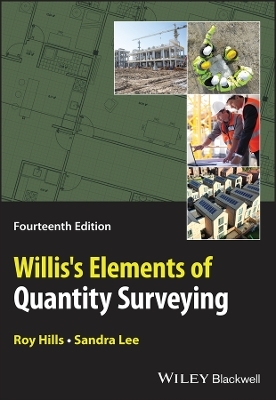
Willis's Elements of Quantity Surveying
Wiley-Blackwell (Verlag)
978-1-394-17782-0 (ISBN)
Quantity Surveying (QS) involves the practice and management of costs related to building and civil engineering projects. Built on the fundamental skill of measuring building quantities, QS practitioners offer a range of services including cost assessments for life cycles, reducing carbon emissions, and more. For almost ninety years, Willis’s Elements of Quantity Surveying has been the indispensable introduction to the theory and practice of quantity surveying. Now updated to reflect the latest standards and practices, it promises to train a new generation of skilled contributors to the building and engineering trades.
Readers of the fourteenth edition of Willis’s Elements of Quantity Surveying will also find:
New chapter on measuring electrical works
Companion website with videos and worked-through examples for instructors
Updates reflecting the 2021 edition of the Royal Institution of Chartered Surveyors’ New Rules of Measurement 2
Willis’s Elements of Quantity Surveying is ideal for all undergraduate students in quantity surveying and related construction disciplines.
Roy Hills, BSc, LLM, MSc, FRICS, is a Programme Leader for Quantity Surveying and a Senior Lecturer in Quantity Surveying at the University of Greenwich, UK. He is a chartered Quantity Surveyor who has worked extensively in industry across both Europe and Asia and is also an assessor for the RICS APC on the QS and PM pathways. Sandra Lee, BSc, MSc, FRICS retd, CIOB retd, is a retired chartered Quantity Surveyor but continues to be involved with surveying education and is a contributor to the associated professional bodies.
Preface xi
Acknowledgements xii
Abbreviations xiii
1 Introduction 1
The modern quantity surveyor 1
The need for measurement 1
The need for rules 1
Establishing the approach 2
Method of study 2
Examples 3
2 Detailed Measurement 5
Method of analysing cost 5
Origin of the bill of quantities 5
The measurement process 6
Attributes of a quantity surveyor 6
Divisions of bill preparation 6
Quantities as part of the contract 7
Contractor-produced quantities and estimates 7
Differences of custom 8
3 The Use of the RICS New Rules of Measurement (NRM) 9
Background 9
The NRM volumes 9
Introduction to NRM2 10
4 Setting Down Dimensions 13
Traditional dimension paper 13
Form of dimensions 14
Timesing 16
Dotting on 17
Waste calculations 18
Alterations in dimensions 18
The descriptions 19
Anding-on 21
Deductions 24
Spacing of dimensions 24
Accuracy 25
Numbering the dimension sheets 25
Cross-references 26
Clearness of the dimensions 26
Headings 27
Notes 27
Insertion of items 27
Squaring the dimensions 28
Scheduling dimensions 28
Using spreadsheets 29
5 Alternative Systems 31
Standardisation 31
Standard libraries 32
Computerised bill production 32
E-tendering 34
Site dimension books 35
Estimating paper 36
6 Preliminary Calculations 37
Mathematical knowledge 37
Perimeter of buildings 37
Centre line of the wall 38
7 General Principles for Taking-Off 45
Receipt of the drawings 45
Preliminary study of drawings 46
Queries with the designers 46
Initial site visit 47
Where to start 47
Organising the work 48
Taking-off by work sections 48
Drawings 48
The specification 49
Sequence of measurement 49
Measurement of waste 50
Overall measurements 50
Use of schedules 50
Use of scales 50
Use of NRM 2 51
Decision on doubtful points 51
Descriptions 51
Abbreviations 52
Extra over 52
Dimensioned diagrams 53
Prime cost items and provisional sums 53
Approximate quantities 54
Summary 54
8 Substructures 55
Particulars of the site 55
Bulking 55
Removing topsoil 55
Bulk excavation 56
Excavation for paths 57
Levels 58
Foundation excavation 58
Earthwork support 59
Disposal of excavated material 60
Working space 60
Concrete foundations 60
Concrete ground slab 61
Brickwork and blockwork in foundations 61
Damp-proof courses 62
Approach taken to measurement in Example 1 62
9 Walls 79
Measurement of brickwork 79
Subdivision 79
Measurement of projections 80
Descriptions 80
Brickwork thickness 80
Common and facing brickwork 80
Cutting, grooves, and the like 81
Returns and reveals 81
Hollow (cavity) walls 81
Bands 81
Special purpose blocks or stones 82
Reinforcement 82
Measurement of arches 82
Blockwork 82
Rendering 82
Stonework 82
Internal partitions 83
Alternative stud partition example 90
10 Floors 97
Timber sizes 97
Subdivision 98
Timber floor construction 98
Staircases 100
Concrete floors 100
Precast concrete beam and pot floors 100
11 Roofs 107
Subdivision 107
Pitched roof construction 107
Roof slopes 109
Hips and valleys 110
Broken-up roofs 111
Trussed rafters 112
Tile or slate roof coverings 112
Eaves and verge finish 113
Rainwater installation 113
Flat roofs 113
12 Internal Finishes 137
Schedules 137
Subdivision 138
Generally 138
Floor finishes 138
Ceiling finishes 139
Wall finishes 139
Angle beads and so on 140
Decoration 140
Cornices and coves 140
Skirtings 140
Wall tiling 141
Internal partitions 141
Dry wall linings 141
13 Windows and Doors 145
Subdivision 145
Schedules 146
Timesing 146
Special features 147
Dormer windows 147
Adjustments 147
Windows and doors 147
Glass 148
Ironmongery 148
Decoration 148
Openings 148
14 Reinforced Concrete Structures 161
Generally 161
Columns 161
Structural floors and roofs 162
Beams 162
Walls 162
Reinforcement 163
Approach to measurement 163
15 Structural Steelwork 177
Fittings 177
16 Plumbing 189
Subdivision 189
Sanitary appliances 191
Foul drainage above ground 191
Cold water 192
Hot water 193
17 Electrical Services 205
18 Drainage Below Ground 213
Subdivision 213
Manholes 213
Drain runs 214
19 External Works 221
Particulars of the site 221
Coverage 221
Site preparation 223
Excavation 223
Roads and paving 224
Walling 224
Fencing 224
Sundry furniture 224
External services 224
20 Preliminaries and Other Priced Bill Sections 233
Generally 233
Preliminaries and general conditions section 233
Part A: Information and requirements 234
Part B: Pricing schedule 236
21 Bill Preparation 241
Abstracting 241
Procedure 241
Division into sections 242
Structure of bills 242
General principles 243
Order of items in the bill 243
Format of the bill 244
Referencing items 244
Units of measurement 244
Order of sizes 245
Use of headings 245
Writing short 245
Unit of billing 246
Framing of descriptions 246
Totalling pages 247
Summary 248
The process of checking 249
Numbering pages and items 249
General final check 249
Cover and contents 250
Other bill types 250
Bill of approximate quantities 251
Schedule of prices or rates 251
Appendix 255
Index 270
| Erscheinungsdatum | 09.03.2024 |
|---|---|
| Sprache | englisch |
| Maße | 171 x 243 mm |
| Gewicht | 539 g |
| Themenwelt | Technik ► Bauwesen |
| ISBN-10 | 1-394-17782-8 / 1394177828 |
| ISBN-13 | 978-1-394-17782-0 / 9781394177820 |
| Zustand | Neuware |
| Informationen gemäß Produktsicherheitsverordnung (GPSR) | |
| Haben Sie eine Frage zum Produkt? |
aus dem Bereich


